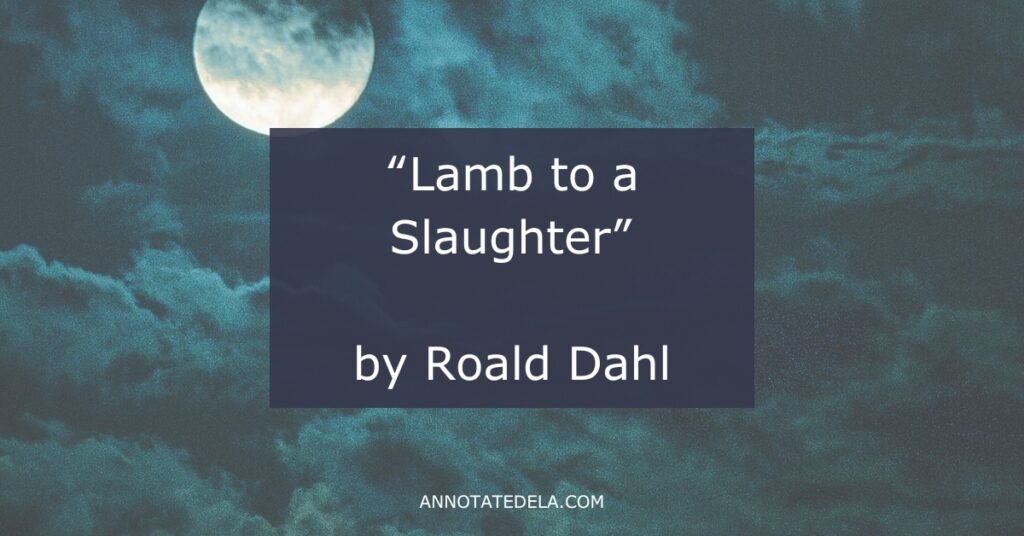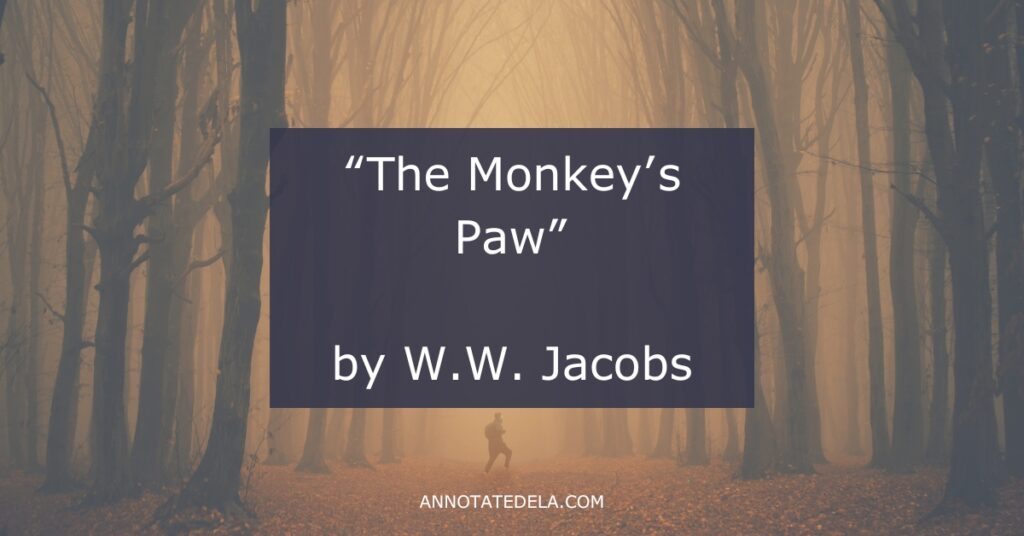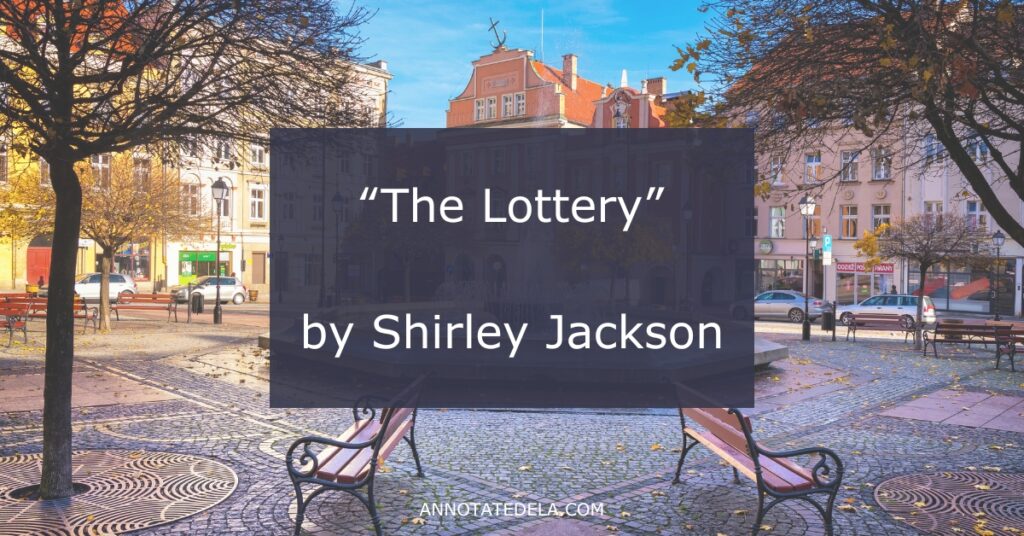It’s the time of year when I want to watch Gilmore Girls and gear up for all the cheesy Hallmark movies, all while I’m planning our children’s Halloween costumes and one of my favorite units – Spooky Stories for Literary Analysis.
Spooky stories are always a hit in the middle school classroom and I love using them to teach literary analysis. Students are engaged and eager to respond to the literature.
Here are 10 spooky stories and the elements of literature we focus on when we are preparing for our spooky stories for literary analysis.
Let’s get to the spooky stuff!
- Monsters Are Due on Maple Street -Rod Serling
- The Tell-Tale Heart – Edgar Allan Poe
- Lamb to a Slaughter – Roald Dahl
- The Monkey’s Paw – W.W. Jacobs
- The Landlady – Roald Dahl
- Three Skeleton Key – George G. Toudouze
- The Outsider – H.P. Lovecraft
- The Lottery – Shirley Jackson
- The Open Window – Saki
- Sorry, Wrong Number – Lucille Fletcher
“Monsters are Due on Maple Street” by Rod Serling

In “The Monsters Are Due on Maple Street,” by Rod Serling, a seemingly ordinary suburban neighborhood is thrown into chaos when all electrical devices suddenly stop working.
Confusion and fear grip the residents as they suspect an alien invasion. Tensions escalate, causing neighbors to turn on each other. The neighbors accuse friends of being disguised as extraterrestrial threats.
However, in a shocking twist, the true ‘monsters’ are the humans themselves. Paranoia and prejudice lead to the breakdown of their community.
Spooky Stories for Literary Analysis Key Elements:
- Irony: The episode employs dramatic irony by leading the audience to believe that the real threat is from extraterrestrial beings. Only to reveal that the true monsters are the humans themselves.
- Symbolism: Maple Street symbolizes a typical suburban community, and the disruption of its peaceful facade symbolizes the fragility of human civilization. The aliens, in this case, symbolize the fear of the unknown that can lead to chaos and division.
- Foreshadowing: The episode uses foreshadowing to hint at the growing tension and paranoia among the neighbors, building suspense throughout the story.
- Character Conflict: There are both internal and external conflicts in the story. The external conflict is the perceived threat from the aliens, while the internal conflicts arise from the characters’ suspicions and mistrust of one another.
- Character Motivation: The characters in the episode are well-developed and serve as archetypes of different personality types and reactions to fear and uncertainty. This helps illustrate the theme of the human condition under stress.
“The Tell-Tale Heart” by Edgar Allan Poe

“The Tell-Tale Heart” is a gripping and psychologically intense short story written by Edgar Allan Poe.
The story begins with the unnamed narrator’s insistence on their sound mental state despite their obsession with an old man’s “vulture eye,” which disturbs them profoundly. The obsession ultimately leads the narrator to meticulously plan and execute the murder of the old man. The narrator believes that the elimination of the eye will rid them of the source of their torment.
After the murder, the narrator is haunted by a guilty conscience and hallucinations of the old man’s heart still beating under the floorboards where they buried the body. The relentless, maddening sound of the heart drives the narrator to confess their crime to the police, believing that they can hear the heart’s tell-tale beat growing louder and louder.
Spooky Stories for Literary Analysis Key Elements:
- First Person Unreliable Narrator: This narrative choice enhances the sense of madness and paranoia throughout the tale.
- Character Motivation: The narrator is a complex character whose descent into madness is meticulously portrayed. Poe’s careful characterization helps readers understand the protagonist’s irrational motives and obsession with the old man’s eye.
- Symbolism: The “vulture eye” symbolizes the narrator’s obsession and irrationality. It becomes a symbol of guilt and the darkness within the narrator’s own soul.
- Character Conflict: The story features both internal and external conflicts. The external conflict is between the narrator and the old man, while the internal conflict is the narrator’s inner struggle with guilt and insanity.
- Foreshadowing: Throughout the narrative, there are hints and clues that foreshadow the narrator’s descent into madness and eventual confession, building suspense and tension.
- Irony: The story employs dramatic irony, as the narrator insists on their sanity while revealing their madness through their actions and confessions. Readers can see the disconnect between the narrator’s perception and reality.
- Setting: The story’s setting, within the confines of a dimly lit room, contributes to the claustrophobic and sinister atmosphere. It emphasizes the narrator’s descent into darkness.
- Narrative Structure and Pacing: The story follows a linear narrative structure, beginning with the narrator’s calm explanation and gradually descending into frenzied madness. This progression adds to the suspense and horror. Poe’s careful control of pacing, with gradual increases in tension, keeps readers engaged and on edge throughout the story.
“Lamb to a Slaughter” by Roald Dahl

In Roald Dahl’s “Lamb to the Slaughter,” the story opens with Mary Maloney, a seemingly happy and devoted housewife, waiting for her husband to come home from work. However, her world is shattered when he reveals a shocking secret and asks for a divorce.
In a fit of rage and desperation, Mary impulsively kills him with a frozen leg of lamb. To cover up her crime, she concocts an elaborate plan, including cooking the murder weapon and serving it to the police officers who come to investigate.
The story takes a darkly humorous turn as the police unknowingly consume the evidence, and Mary appears to get away with her crime.
Spooky Stories for Literary Analysis Key Elements:
- Irony: The story is rich in dramatic irony, where readers are aware of Mary’s crime while the police remain clueless, creating tension and humor.
- Character Motivation: Mary Maloney is a well-developed character who undergoes a drastic transformation from a seemingly docile housewife to a cunning and resourceful murderer. The story is primarily told from Mary’s perspective, allowing readers to understand her thoughts and emotions, even as her actions become increasingly shocking.
- Setting: The story’s domestic setting, initially presented as a cozy and typical household, becomes a stark contrast to the dark events that unfold, contributing to the story’s impact.
- Foreshadowing: Dahl skillfully uses subtle foreshadowing to hint at the impending violence, creating a sense of unease and anticipation in the reader.
- Mood and Tone: The story shifts in mood from domestic tranquility to tension and suspense, with a darkly humorous tone that underscores the absurdity of the situation.
- Plot Twist: The story’s resolution is unexpected and serves as a twist ending, leaving readers with lingering questions about justice and morality.
“The Monkey’s Paw” by W.W. Jacobs

In “The Monkey’s Paw,” by W.W. Jacobs the White family comes into possession of a magical monkey’s paw that grants them three wishes.
While initially excited, they are warned by a visitor that the wishes come with dire consequences. Despite the warning, they make their first wish, leading to a tragic accident that claims the life of their son.
Overwhelmed by grief, they make a second wish to bring him back from the dead, but this wish only brings horror and terror. Realizing the paw’s malevolent nature, they use their final wish to undo the previous two, bringing their son’s tormenting spirit to a halt.
Spooky Stories for Literary Analysis Key Elements:
- Foreshadowing: The story effectively uses foreshadowing to build anticipation and dread, particularly through the visitor’s warnings about the paw’s consequences.
- Symbolism: The monkey’s paw itself serves as a powerful symbol of desire and the potential consequences of making impulsive and selfish wishes.
- Irony: The story is rich in irony, particularly when the first wish leads to the tragic death of their son, contradicting the White family’s initial hopes for happiness.
- Plot Pace: The pacing and progression of events contribute to the suspenseful atmosphere.
- Character Conflict: The characters, particularly Mr. and Mrs. White, are well-developed, and their emotional struggles and reactions to the paw’s consequences add depth to the narrative.The central conflict revolves around the family’s struggle with the consequences of their wishes and the moral dilemma they face.
- Setting: The story’s setting, a remote and gloomy house in a small village, creates a sense of isolation and unease, enhancing the eerie atmosphere.
- Mood and Tone: The story begins with a cozy and domestic tone but gradually shifts to one of tension, dread, and foreboding.
- Narrator: The story is primarily told from a third-person perspective, providing insight into the characters’ thoughts and feelings while maintaining an objective viewpoint.
- Plot Twist: The story concludes with a chilling twist ending that leaves readers with a haunting sense of the paw’s malevolent power.
“The Landlady” by Roald Dahl

In Roald Dahl’s “The Landlady,” a young man named Billy Weaver arrives in the town of Bath for a business trip and seeks accommodation. He stumbles upon a quaint and seemingly welcoming boarding house run by the eccentric landlady.
As Billy settles in, he notices peculiar details, such as the names of previous guests in a guest book and the preserved pets displayed in the house.
The story takes a chilling turn as Billy realizes that something is not quite right about the landlady and the fate of the previous guests.
Spooky Stories for Literary Analysis Key Elements:
- Setting: The story’s setting, a cozy and seemingly harmless boarding house, provides a stark contrast to the sinister events that unfold. This setting contributes to the story’s atmosphere and tension.
- Mood and Atmosphere: Dahl masterfully creates a mood of unease and foreboding from the very beginning, drawing readers into a sense of disquiet and curiosity.
- Foreshadowing: Dahl uses foreshadowing to hint at the landlady’s true nature, creating a sense of anticipation and unease. The odd details in the boarding house, such as the guest book and the preserved animals, foreshadow the story’s dark twist.
- Irony: The story is rich in dramatic irony, as readers are aware of the danger that Billy is in while he remains oblivious to the true nature of the landlady.
- Narrator: The story is primarily told from a third-person limited perspective, allowing readers to understand Billy’s thoughts and feelings while maintaining a degree of distance from the landlady’s perspective.
- Plot Twist: The story concludes with a chilling twist ending that leaves readers with a lingering sense of dread and questions about the landlady’s motivations.
“Three Skeleton Key” by George G. Toudouze

In “Three Skeleton Key,” by Georges G Toudouze three lighthouse keepers find themselves trapped on a remote island when their lighthouse becomes infested with a horde of deadly rats.
As the rats overrun the island, the keepers must rely on their resourcefulness and teamwork to survive. The story explores themes of isolation, courage, and the power of human determination in the face of overwhelming odds.
The tension builds as the rats relentlessly besiege the lighthouse, and the keepers must find a way to fend off the vermin and signal for help. This classic short story provides a thrilling and suspenseful experience for readers and serves as an excellent choice for middle school literature discussions.
Spooky Stories for Literary Analysis Key Elements:
- Setting: The story’s setting, a remote lighthouse on an isolated island, creates a sense of isolation and helplessness, intensifying the atmosphere of dread and danger. The vivid imagery of the rats and the keepers’ battle to protect themselves from the relentless horde create an atmosphere of dread that lingers long after the story ends.
- Mood: The story effectively builds a mood of suspense and terror, immersing readers in the lighthouse keepers’ desperate struggle to survive the rat infestation.
- Conflict: The central conflict revolves around the keepers’ battle for survival against the relentless horde of rats. This external conflict drives the plot and reveals the characters’ strengths and weaknesses.
- Narrator: The story is narrated in the first person by one of the lighthouse keepers, which allows readers to experience the terror and tension through the protagonist’s perspective.
- Imagery: The story employs suspenseful techniques, such as the slow buildup of tension, vivid descriptions of the rats, and the keepers’ increasingly desperate situation, to engage and captivate the reader.
“The Outsider” by H.P. Lovecraft

In H.P. Lovecraft’s “The Outsider,” an unnamed narrator describes a life of isolation and confinement within a decaying castle. He has no memory of his past and exists in darkness and solitude.
One day, driven by curiosity, he climbs the castle’s seemingly endless spiral staircase and emerges into a grand banquet hall filled with grotesque revelers. As he gazes at his own reflection in a mirror, he realizes his true nature as a hideous and corpse-like being.
Shocked and horrified, he flees from the castle, descending into darkness once more.
Spooky Stories for Literary Analysis Key Elements:
- Atmosphere and Mood: Lovecraft excels in creating a dark and foreboding atmosphere. In “The Outsider,” the pervasive sense of isolation, decay, and dread contributes to a mood of profound unease and horror.
- Setting: The story is set in a decaying and labyrinthine castle, which serves as a gothic and eerie backdrop. The castle symbolizes the narrator’s psychological confinement and the unknown horrors that lie within.
- Symbolism: The mirror and the revelation of the narrator’s true nature serve as powerful symbols in the story. They represent the idea of self-discovery, the horror of confronting one’s own identity.
- Narrator: The first-person perspective immerses the reader in the narrator’s thoughts and experiences, creating a sense of psychological intimacy and allowing the reader to share in the narrator’s shock and horror.
- Imagery: Lovecraft’s vivid and unsettling imagery, such as the description of the grotesque revelers and the decayed surroundings, heightens the story’s sense of horror and otherworldly strangeness.
- Plot Twist: The story follows a linear narrative structure, but it takes a turn when the narrator’s revelation occurs, adding an element of surprise and shock.
- Foreshadowing: The story employs foreshadowing, hinting at the narrator’s true nature through his descriptions of isolation and confinement in the castle.
- Irony: The story is marked by dramatic irony, as the reader gradually becomes aware of the narrator’s true identity before the narrator does, intensifying the sense of horror.
“The Lottery” by Shirley Jackson

In “The Lottery” by Shirley Jackson, the story is set in a seemingly ordinary small town where, on a sunny summer day, the townspeople gather for the annual lottery.
The lottery is a ritual that has been passed down through generations, with each family drawing a slip of paper from a black box. The person who draws a slip with a black dot is chosen as the ‘winner.’
As the tension builds, it becomes clear that the ‘winner’ will face a grim fate. In a shocking and chilling twist, the lottery’s dark purpose is revealed as the townspeople turn on the ‘winner’ and participate in a brutal stoning.
Spooky Stories for Literary Analysis Key Elements:
- Setting: The story is set in a seemingly idyllic small town on a sunny summer day, creating a stark contrast between the peaceful surface and the disturbing events that unfold. The setting underscores the idea that horror can lurk beneath the ordinary.
- Symbolism: The black box, the slips of paper, and the black dot symbolize tradition, randomness, and the grim outcome of the lottery, respectively. These symbols represent the story’s topics of blind conformity and the inhumanity of tradition.
- Foreshadowing: Shirley Jackson uses subtle hints and clues throughout the story to foreshadow the shocking climax, creating a sense of unease and anticipation in the reader.
- Character Motivation: While the characters are not deeply developed individually, they collectively represent the townspeople’s complicity in the ritual, highlighting the power of peer pressure and groupthink.
- Irony: The story is rich in dramatic irony, as the townspeople go about their normal activities and socialize before the lottery, unaware of the horrifying fate that awaits one of them.
- Plot: The story follows a linear plot structure, with a gradual buildup of tension leading to the shocking climax and resolution, leaving readers with lingering questions about the morality of the lottery.
- Narrator: The story is told from a third-person limited perspective, primarily focusing on the thoughts and experiences of Tessie Hutchinson, the chosen victim, which allows readers to connect with her perspective.
“The Open Window” by Saki

In Saki’s “The Open Window,” a young boy named Framton Nuttel arrives at the country home of Mrs. Sappleton to treat his nervous condition. While waiting for Mrs. Sappleton to receive him, he engages in conversation with her niece, Vera.
Vera tells Framton a fictional story about her aunt’s husband and two brothers, who went out hunting three years ago and never returned. She explains that her aunt keeps the window open, expecting them to return someday.
As Mrs. Sappleton enters the room and talks about her husband and brothers, Framton becomes horrified, thinking he has seen the ghosts of the deceased men.
In a humorous twist, it is revealed that Vera had fabricated the entire story, leaving Framton in a state of shock.
Spooky Stories for Literary Analysis Key Elements:
- Irony: The story is rich in situational irony. The audience is led to believe that Vera’s story about the returning men is true, only to discover that it’s an elaborate fabrication. The twist ending, where Framton believes he has seen ghosts, is a classic example of irony.
- Character: Vera is a well-developed character who uses her cleverness and imagination to manipulate Framton Nuttel. Her ability to craft a convincing story adds depth to her character.
- Setting: The story’s setting, a country home in a rural area, provides a serene and unassuming backdrop for the unfolding events. This setting contrasts with the unexpected twists and turns of the narrative.
- Narrator: The story is primarily told from a third-person limited perspective, focusing on Framton Nuttel’s experiences and reactions. This narrative choice allows the reader to share in Framton’s confusion and eventual shock.
- Plot Structure: The story follows a linear plot structure, with an introduction, rising action, climax, and resolution. The pacing and progression of events contribute to the humor and surprise.
- Foreshadowing: Saki uses foreshadowing to hint at the impending twist, creating a sense of anticipation and curiosity in the reader as Vera spins her story.
- Dialogue: The witty and playful dialogue between Vera and Framton is a key element that drives the plot forward and adds to the story’s humor.
“Sorry, Wrong Number” by Lucille Fletcher

In Lucille Fletcher’s “Sorry, Wrong Number,” the story revolves around Mrs. Elbert Stevenson, an invalid woman who is confined to her bed.
One evening, she overhears a telephone conversation on a crossed line, in which she hears two men plotting a murder that is set to occur that night.
Desperate to prevent the crime, she tries to alert the authorities, but her efforts are repeatedly thwarted by miscommunications and apathy.
As the tension builds, Mrs. Stevenson’s fear intensifies as she realizes she may be the intended victim.
In a shocking climax, the truth about the murder plot is revealed, leaving Mrs. Stevenson in a state of terror and helplessness.
Spooky Stories for Literary Analysis Key Elements:
- Point of View/Narrator: The story is primarily told from the first-person perspective of Mrs. Elbert Stevenson. This narrative choice allows readers to intimately experience her fear, frustration, and desperation.
- Conflict: The central conflict is the race against time to prevent a murder that Mrs. Stevenson overhears on the telephone. The story also highlights the conflict between Mrs. Stevenson and the various people she contacts for help.
- Foreshadowing: The story uses foreshadowing to build tension and anticipation. As Mrs. Stevenson frantically listens to the phone conversations, the impending danger becomes more apparent.
- Irony: The story is marked by dramatic irony, as readers are aware of the danger that Mrs. Stevenson is in, while she remains unaware of the full extent of the threat.
- Setting: The setting is crucial to the story’s atmosphere, as Mrs. Stevenson is confined to her bed and her home. This setting of isolation amplifies her vulnerability and adds to the suspense.
- Dialogue: The story’s dialogue is pivotal in conveying Mrs. Stevenson’s desperation and the urgency of her situation. It serves as a driving force behind the narrative.
- Plot Structure: The story follows a linear plot structure with an introduction, rising action, climax, and resolution. The pacing and progression of events contribute to the story’s suspense.
- Plot Twist: The story concludes with a shocking and unexpected twist, revealing the truth about the murder plot and leaving readers with a sense of both relief and lingering unease.
Bonus Spooky Stories for Literary Analysis:
The Highwayman by Alfred Noyes
The Pit and the Pendulum by Edgar Allan Poe
The Cask of Amontillado by Edgar Allan Poe
The Legend of Sleepy Hollow by Washington Irving
The Veldt by Ray Bradbury
These spooky stories for middle school can be used in many ways, literary analysis is just one way to engage students in the art of the spooky tale.
Want more support with literary analysis and spooky stories, grab the Literary Analysis: Spooky Stories Resource.





One Response